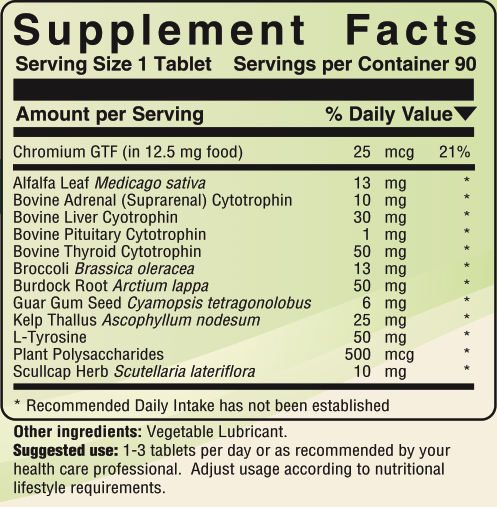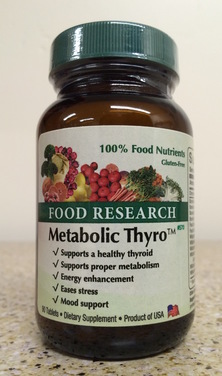
90 Tablets $21.98
| Hypothyroid | Hyperthyroid | |||||
| Dry coarse skin and hair | 70-97% | Nervousness | 99% | |||
| Fatigue, lethargy, mental or physical slowness | 70-91% | Excessive sweating | 89% | |||
| Edema, puffy hand, face, or eyes | 67-95% | Hypersensitivity to heat | 89% | |||
| Cold intolerance | 58-95% | Palpitation | 89% | |||
| Decreased sweating | 68-89% | Fatigue | 88% | |||
| Hoarseness | 48-74% | Weight loss | 85% | |||
| Constipation | 36-61% | Tachycardia | 82% | |||
| Weight gain | 48-76% | Difficulty breathing | 75% | |||
| Loss or thinning hair | 32-57% | Weakness | 70% | |||
| Menstrual disturbance | 16-30% | Diarrhea | 23% | |||
| Bradycardia | 14% | Weight gain | 2% |
As the preceding lists show, some symptoms overlap (and many people have a mixture of symptoms). Other studies have also implicated high cholesterol, depression, headaches, cardiovascular, and other problems with the thyroid [1-5]. Current and historical references suggest that substances contained within the ingredients in Metabolic Thyrocan nutritionally help support the thyroid gland and promote better overall metabolism. Note: many believe glandulars provide nutritional support for the type of gland they are [6-13].
Metabolic Thyro contains the following Foods:
Adrenalglandulars are a Food which has been used for decades by nutrition-oriented doctors when adrenal concerns are suspected. The adrenal glands help the body deal with stress, but high stress weakens the adrenal glands [14]. Fatigue and metabolic problems are common symptoms of adrenal insufficiency [15]. It should be noted that it is well accepted that hypoadrenalism results in “increasing the frequency of hypoglycemia” as well as “hypothyroidism” [15]. Salt craving is a common symptom of hypoadrenalism [15]; it can also be involved in hypothyroidism [3]. The adrenal cortex produces the hormone cortisol which helps control organic metabolism and responses to stress [4].
Alfalfa is believed by some herbalists have a “beneficial effect on the pituitary gland”, “helps in chemical imbalance”, “neutralizes uric acid for arthritis”, and “is useful as a Food to prevent cholesterol accumulation in the veins” [16]; this last point is supported by several animal studies [17].
Burdock is believed by some to be helpful in “fortifying the immune system” [18]. It has several historical uses including helping with skin disorders “particularly when they are caused by a system imbalance. It stimulates the digestive juices and bile secretion and therefore is useful in treating anorexia nervosa and digestion and appetite problems” [19]. Some believe, in addition to helping with digestive concerns, burdock “aids the pituitary gland to help adjust hormone balance” [16]. Burdock has sometimes been recommended for thyroid health [16].
Chromium GTF in Food is organically attached. Inorganic chromium “is very difficult to absorb”, but organically attached chromium 10-25 times “more easily absorbed” [20,21]. “Chromium is generally accepted as an essential nutrient that potentiates insulin action and thus influences carbohydrate, lipid, and protein metabolism” [20].
Guar gum seed is a water soluble fiber (in the form of a galactomannan), extracted from locust beans, which appears to have some of the same benefits as other dietary fiber [22-24].
Kelp is a Food high in minerals, especially iodine [25]. Kelp has long been used (since 3000 B.C.) to provide nutritional support for the thyroid gland [16,18,21]. Gary Null, Ph.D., has written, “Kelp can rebalance thyroid metabolism, resulting in successful weight management and the reversal of many conditions which are caused by a thyroid imbalance, including stomach and respiratory disorders” [18]. The body’s sole function of the mineral iodine is for the thyroid to make thyroid hormones (T1,T2,T3, & T4) [1,4,21].
L-tyrosine an amino acid required for the production of thyroid hormones, T1,T2,T3, and T4 [4].
Liver glandulars have sometimes been recommended by nutrition-oriented practitioners for some with metabolic concerns [5,11,20]. The liver is involved in blood sugar regulation, conversion of T4 to T3, and a variety of enzymes [4].
Pituitary glandulars have long been used by doctors [11,26]. The pituitary produces the thyroid stimulating hormone which signals to the thyroid that it needs to work and make its own hormones [4].
Scullcap (also spelled “skullcap”) is a member of the mint family and is often used as a tonic for ‘female weakness’ [9,17,27].“These [tonics] are plant remedies that either strengthen or enliven a specific organ or the whole body. They are truly Nature’s gifts to a suffering humanity” [27]. Even the United States Pharmacopoeia has long recognized scullcap as a nervine and tonic [9]. It also is recommended by some herbalists for thyroid concerns [16].
Thyroid glandulars have long been used by doctors to nutritionally support the thyroid [9,12]. The 1916 edition of the United States Pharmacopoeia states that the following concerning thyroid glandulars, “exerting a strong influence on the nutritive and metabolic processes. Used in the treatment of myxdema, cretinism and obesity” [9]. Dr. Cass Ingram also prefers glandulars to synthetic thyroid medications when low thyroid is suspected [3]. There are reports that many who do not test positive for clinical hyper- or hypothyroidism who take thyroid glandulars have sometimes reported improvement in many symptoms associated with hyper and hypothyroidism [3,5,11,26].
Many people simply take Metabolic Thyro to feel better.

Metabolic Thyro naturally contains carbohydrates (including all known essential monosaccharides), essential lipids, and proteins (including all ten essential amino acids) as found in specially grown, enzymatically processed Saccharomyces cerevisiae and the individually listed foods. All glandulars are New Zealand source. Metabolic Thyro contains no synthetic USP nutrients or isolated mineral salts.
Numerous university studies have concluded that supplements containing food nutrients are better than USP isolates. Food nutrients are better because they contain important enzymes, peptides, and phytonutrients CRITICAL to the UTILIZATION of vitamins and minerals which are not present in isolated USP nutrients. Published research has concluded that food vitamins are superior synthetic/USP vitamins.
Suggested
use: 1-3 tablets per day or as recommended by your health care
professional. Adjust usage according to nutritional lifestyle
requirements.
REFERENCES
[1] Robbins J, Rall JE, Gorden P. The thyroid and iodine metabolism. In Duncan’s Diseases of Metabolism, 7th ed. WB Saunders, Phil.:1009-1104, 1974
[2] Hickie I, et al. Clinical and subclinical hypothyroidism in patients with chronic and treatment-resistant depression. Aust NZ J Psychiatry,1996;30(2):246-252
[3] Igram C. Who Needs Headaches? Literary Visions: Hiawatha (IA), 1991
[4] Guyton AG, Hall JE. Textbook of Medical Physiology, 9th ed. W.B. Saunders Co., Phil., 1996
[5] Thiel R. Nutritional Interventions for the Thyroid. ANMA Monitor, 2000;4(1):6-14
[6] DeCava JA. Glandular supplements. Nutrition News and Views 1997; 1(3):1-10
[7] Burns D. Growing scientific evidence support glandular therapy. Digest of Chiropractic Economics, Nov/Dec 1987:74-79
[8] Schwartz EF. Glandular therapy. American Chiropractor, Jan/Feb 1983:14-18
[9] Wright J., et al. A Guide to The Organic Drugs of the United States Pharmacopoeia, 9th rev. Eli Lilly, Indianapolis, 1916
[10] Thiel RJ. Combining Old and New: Naturopathy for the 21st Century. Whitman Publications, Warsaw (IN), 2000
[11] Versendaal DA. Contact Reflex Analysis and Applied Trophology. D.A. Versendaal, Holland (MI); 1990
[12] Harrower H. Practical Organotherapy, 3rd ed. W.B. Conkey, Hammond (IN), 1921
[13] Gardner M. Intestinal absorption of intact peptides and protein from the diet - a neglected field? Biological Reviews,1984;59:289-331
[14] Amberson JB, Gray GF. Adrenal pathology. In Adrenal Disorders. Thieme Medical Publishers: New York; 1983:13-36
[15] May ME, Vaughn ED, and Carey RM. Adrenocortical insufficiency - Clinical Aspects. In Adrenal Disorders. Thieme Medical Publishers: New York; 1983:171-189
[16] Tenney L. Health Handbook. Woodland Books, Provo, 1987
[17] Alfalfa; Scullcap. In The Review of Natural Products 2001. Facts and Comparisons, St. Louis, 2000
[18] Null G. The Complete Encyclopedia of Natural Healing. Kensington Books, 1998
[19] Scalzo R. Naturopathic Handbook of Herbal Formulas. Kivaki Press, Durango (CO), 1991
[20] Nielsen F. Chromium. In Modern Nutrition in Health and Disease, 8th ed. Lea & Febiger, Phil.; 1994:264-268
[21] Ensminger AH, Ensminger ME, Konlande JE, Robson JRK. Food & Nutrition Encyclopedia, 2nd ed. CRC Press, New York, 1993
[22] Donald B. Hypocholesterolemic effects of a dietary fiber supplement. Am J Clin Nutr,1994;59:1050-1054
[23] Haskell WL, et al. Role of water-soluble dietary fiber in the management of elevated plasma cholesterol in healthy subjects. Am J Cardiology,1992;69-4333-439
[24] Burdock GA. Encyclopedia of Food and Color Additives, Vol. II. CRC Press, New York, 1997
[25] Seaweed, kelp, raw. USDA Nutrient Database for Standard Reference, Release 11-1, August 1997
[26] Lee R. Adrenamin, Pituitary Cytotrophin, and Thyroid Cytotrophin. In Product Bulletin. Standard Process, Palmyra (WI), Circa 1950
[27] Hoffman D. The Herb Handbook. Healing Arts Press, Rochester (VT); 1988
Some of these studies (or citations) may not conform to peer review standards, therefore, the results are not conclusive. Professionals can, and often do, come to different conclusions when reviewing scientific data. None of these statements have been reviewed by the FDA. All products distributed by Doctors’ Research, Inc. are nutritional and are not intended for the treatment or prevention of any medical condition.
 |
||
|
||
